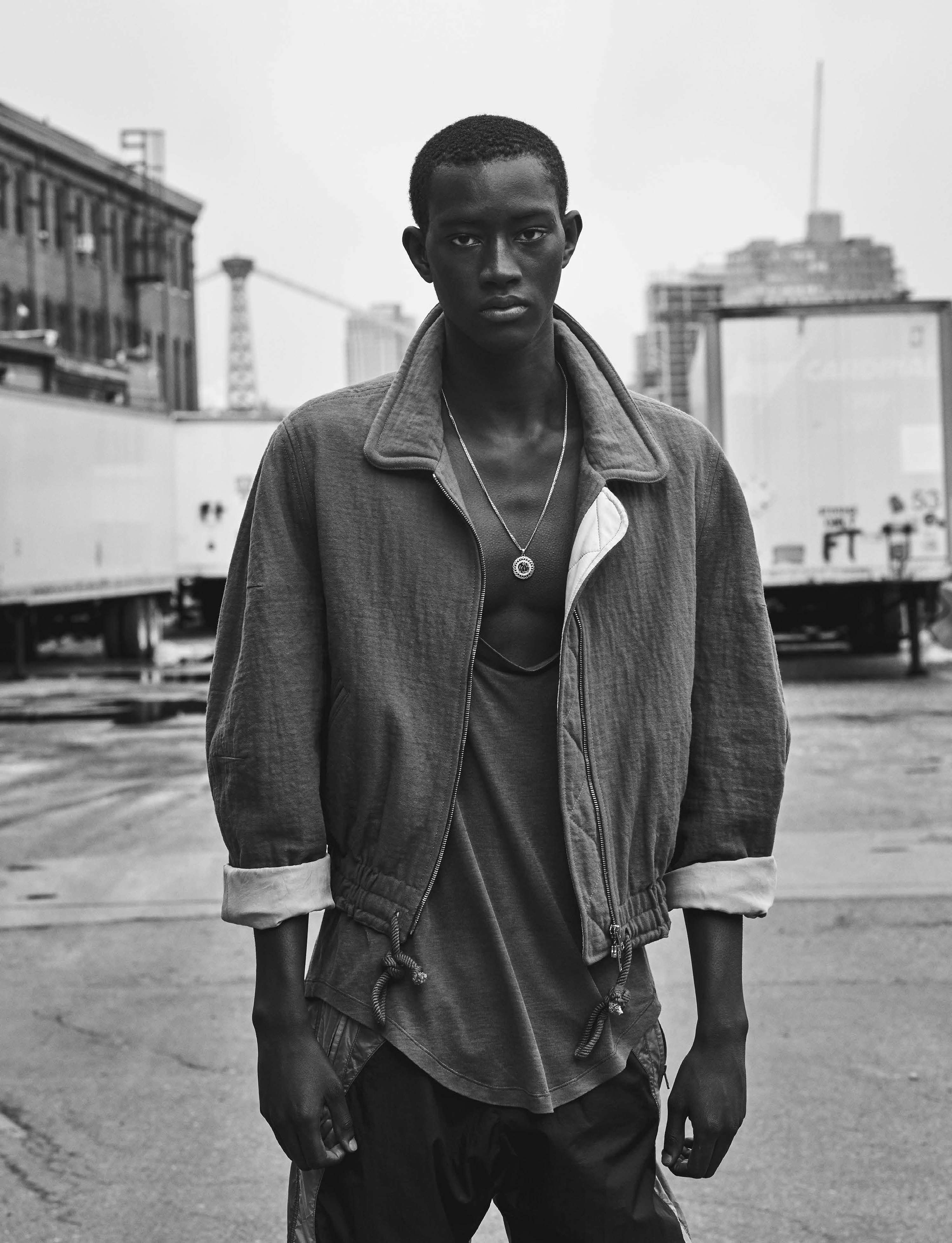French style has long been synonymous with Isabel Marant, but men after the designer’s iconic look were always left hanging at the women’s rail. That is, until now. After 24 years of womenswear, the designer has answered the prayers of her male fanbase with her first dedicated menswear collection.
Launched during fashion week in Paris last September, it’s everything you’d hope to see from Isabel Marant menswear. That is, it’s much the same as the womenswear. Effortlessly cool, it carries the masculine-feminine tension that’s been with the designer since go – from early days crafting jewellery and knitwear, through to the ‘94 launch of her clothing brand, to the more casual Isabel Marant Étoile line, and ultimately to her status as one of the biggest names in French fashion.
On the phone at her Paris studio, she explains her baseline for this new chapter: “The starting point is always from the womenswear.” Simple – Marant doesn’t design for drama. Merging polished and bohemian, sports and luxury, high and low, she’s all about dressing people for real life. A practical attitude shared by the men who’ve already been wearing her women’s pieces for years.
Tempe Nakiska: So why menswear?
Isabel Marant: For ages I’ve been hustled by men surrounding me, saying, “I want my wife’s sweater, why don’t you do it for men?” I’ve got a lot of friends and even guys who work in the company who are wearing the women’s collection, ordering it in larger sizes, and it’s nice to see how it can cross over. But it’s not a big surprise for me, because I was always very inspired by men’s wardrobes and there were always androgynous pieces in my collection.
Tempe: And there were some men’s pieces in your collaboration with H&M, right?
Isabel: Yes we did a little capsule collection for men’s that was very successful, and some of the men who had the chance to buy some are now crying to me saying their pieces are reaching their end point, they’ve been wearing them so much that we “muuuuust” release something more!
Tempe: Have you had fun with it?
Isabel: Yeah, because menswear is less dramatic than womenswear. There is something a bit more light and natural with it, you’re not forcing yourself as much as with womenswear where there is so much going on all the time. It’s true that [in womenswear] we have a lot of eyes on us and it’s a lot of pressure, and I don’t think this exists to the same extent in menswear.
Tempe: You’re known for wearing your own collections, will you be wearing the menswear?
Isabel: Oh for sure. That’s something great for me, because I’m feminine but wear a lot of tomboy-ish things, and sometimes I’m frustrated because my commercial people always want me to do very feminine pieces. Sometimes there are pieces I want to put in the womenswear but it’s not so easy, but having menswear means I can do them. Also, it’s very well known that women take the clothes of their boys, I’m living the reverse situation a lot. I think nowadays, the gap between menswear and womenswear is fading. It’s life – you have women who love women, women who love women and men, there’s everything. I quite like this idea of an almost unisex wardrobe, and a part of your wardrobe that is quite interchangeable and that can be in common between a man and woman.
Tempe: Is it like this in your house?
Isabel: Well my husband wears exactly the same size as I do, and he has a certain femininity about him, so my clothes were always looking super great on him. Sometimes you have a neckline of a sweater that is a bit too deep – it’s tiny things that make it work for men’s or not. And I like to share. When I go to Nike I go to the men’s range, not the women’s. And now my son is the same size as us, so we now have a wardrobe for three [laughs].
Tempe: Were you thinking about your husband and son for the menswear?
Isabel: Yes of course. It’s like the woman’s, it’s everybody surrounding me – there are a lot of different kinds of figure in my office, and in my life and I always observe what people are wearing and for which reasons.
Tempe: And when designing the menswear, where do you start?
Isabel: The starting point is always from the womenswear. From there, I work out what I want to translate from the collection and go on to add different things. When you work in fashion the time is flying away very quickly. With each season I’m telling myself a story, and it’s the same for men and women. We are living in the same world at the same time, so for me there’s no reason for me to think differently. If I do checks and red for woman I feel the same for menswear as well.
Tempe: What were you wearing when you were much younger?
Isabel: When I was a teenager I was completely against fashion. It was the 80s so it was really about wearing a lot of make-up and big shoulders, the time of Claude Montana and [Thierry] Mugler, which is quite the opposite of the kind of fashion I’m doing. I think when we were teenagers we were very rebellious towards what our parents were wearing, which is very funny because nowadays the kids often want to wear what their parents are wearing. But in our time it was really the ‘don’t do’ thing!
Tempe: I remember reading about how in your teen years you were sourcing and customising army jackets.
Isabel: I was going a lot to flea markets in Paris, one in Saint-Antoine. We had this moment when I was sixteen or seventeen, we used to go clubbing and come straight out to the flea market to buy the out t for the next night out. We’d buy shitty things for one or two euros and rework them during the week, preparing our outfits for the weekend.
Tempe: I feel like that tactile, by-hand ethos has carried through all of your collections.
Isabel: Yes, and then I was very inspired by craft, by the different cultures of the world. When I was younger I was a big traveller, with my backpack, going to India, Mexico, Africa, Asia. I was always amazed by the talent of people with their hands and their heads and using almost no tools yet being able to create great fabrics and jewellery. Even when you look at the old buildings and think about how they didn’t have any machines and yet could achieve such magnificent things; that touches me a lot. I think that’s one of the aspects of fashion that I like the most – that we have kept this crafty side. Even if fashion is an industry, there is always a person behind it. You have the opportunity to work with embroiderers, or those doing jewellery, and this side of fashion is really important to me.
Tempe: You started out with jewellery, no?
Isabel: When I launched my label I was twenty and I couldn’t really invest in a garment collection, so I started with that. I never dreamed of being a big designer or anything like this, when I was younger I was set on doing economical studies and not fashion at all. I just played with garments as I had a very precise idea of what I wanted to wear, and then I started to do my own clothes and some of my friends asked me to do some for them. Step by step I started to sell them, and at the age of sixteen I was earning a real salary. I started to think there was something interesting there, and I had a lot of fun discovering all the designers of the time. I was quite naïve about fashion, I didn’t have a very strong idea of what it was, but I became more interested in that world and went to fashion school.
Tempe: You seem to have come from a very real place, from your career beginnings to your clothes now. I wonder how that comes through in your process?
Isabel: Before starting a collection, I always ask myself a lot of philosophical questions. There are so many clothes and propositions, so it’s important to know what will make the difference when it comes to someone buying your piece. I always like things better when they help you feel comfortable and at ease. Every morning I can put on a very beautiful blouse but if I don’t feel comfortable I won’t wear it. I take the phrase ‘ready-to-wear’ literally because in fashion what interests me is dressing people for their everyday life, and not for special occasions. My interest is, “What do I wear today?” and why I want to wear that more than another thing. It’s a very down-to-earth reflection.
Tempe: Does music also inform your way of working?
Isabel: I think music is one of my most inspiring sources – when I’m drawing or working I need music, it gives me the tempo and the energy of the collection. When I started in fashion, one day we were punk kids, the day after we were ragga, and the day after we were more disco... We were playing a lot and having a lot of fun with clothes and following music trends. In music I think it’s a similar way of working, putting songs together in a way that resembles how I assemble ideas together in fashion.
Tempe: What were you listening to when you were designing the mens?
Isabel: It was a while ago, I’m just checking my playlist, I have hundreds of playlists [pause]. Ah, there was one that I was very into, SBTRKT. There’s a song called Right Thing To Do.
Tempe: What do you do on the weekends?
Isabel: Very often I’m going away, we have a little cabin in the forest with no water or electricity, and it’s super tiny but it’s just a dream. We spend some time with friends and family doing very simple things like gardening and cooking. We have petrol lamps and I’ve got a gas oven which I’m cooking on a lot, I love cooking. It’s more a question of emptying your mind of all the stress from the week and doing very simple things – playing cards with friends and building tree houses with my son. We have a river so we do a lot of paddle-boarding in the summer time.
Tempe: It sounds like bliss.
Isabel: Yeah, I spend my week stuck in the office, I don’t even have time to go out for lunch. So I need some time doing things outside, just to see green and blue sky. It’s really clearing your mind.
Photography BLAIR GETZ MEZIBOV
Fashion GRO CURTIS. All clothes ISABEL MARANT
Published in HERO MAGAZINE, SUMMER/FALL '18





